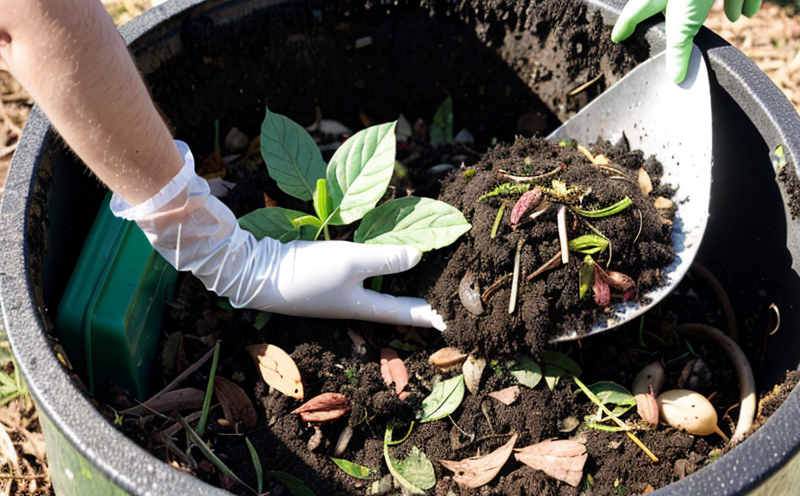ISO 17625 Phosphatase Activity Testing in Compost Materials
The ISO 17625 standard is a globally recognized method designed to measure phosphatase activity, an enzyme crucial for the breakdown of organic matter. This test is particularly important in waste management and composting processes as it provides insights into the biological decomposition efficiency of the compost material.
Phosphatase enzymes are vital for the mineralization process, where they help convert insoluble phosphate compounds into a form that can be utilized by plants. Ensuring adequate phosphatase activity within compost materials is essential to enhance nutrient availability and improve soil fertility. This testing method helps in assessing the maturity of the compost, ensuring it meets quality standards and regulatory requirements.
The standard procedure involves incubating samples under controlled conditions, followed by measuring the released phosphate using spectrophotometric techniques. The test provides a quantifiable measure of phosphatase activity, which is critical for understanding the biological breakdown process in compost materials.
This service is particularly beneficial for quality managers and compliance officers who need to ensure that their compost products meet stringent international standards. For R&D engineers, this testing can provide valuable data to optimize compost formulations and improve product performance. Procurement teams can rely on these results to verify the quality of incoming compost materials against specified criteria.
The phosphatase activity test is part of a broader suite of tests that help ensure the quality and safety of compost materials. By measuring this enzyme, we are not only adhering to international standards but also contributing to sustainable waste management practices.
Understanding the role of phosphatase in composting helps us appreciate why this testing method is so important. It aids in creating high-quality compost that can effectively enhance soil health and support plant growth. This service ensures that compost materials are not only safe for use but also environmentally responsible, aligning with global sustainability goals.
The ISO 17625 standard is widely accepted across various sectors including agriculture, horticulture, and environmental management. Its adoption by regulatory bodies underscores its importance in ensuring the quality of organic matter decomposition processes.
Industry Applications
| Application | Description |
|---|---|
| Agriculture | Evaluating the nutrient availability in compost used for soil amendment. |
| Horticulture | Determining the maturity and quality of compost used as a growing medium. |
| Environmental Management | Assessing the effectiveness of waste-to-compost conversion processes. |
| Composting Facilities | Monitoring the biological activity in compost to ensure optimal decomposition rates. |
The ISO 17625 test is particularly valuable for facilities that manage organic waste and produce compost. By measuring phosphatase activity, these entities can verify the quality of their products and ensure they meet regulatory standards. This testing method helps in maintaining a consistent supply of high-quality compost, which is essential for sustainable agricultural practices.
Understanding the role of phosphatase in composting also highlights its importance for environmental management. The test ensures that compost materials are not only safe but also contribute to reducing waste and promoting recycling.
Quality and Reliability Assurance
The ISO 17625 testing method is renowned for its reliability and precision, making it a preferred choice for quality assurance in compost production. The standard specifies detailed procedures that ensure consistent results across different laboratories and locations.
The testing process begins with the collection of representative samples from various stages of the composting process. These samples are then prepared according to specific protocols outlined in the ISO 17625 standard. This includes homogenizing the material, ensuring it is free from contaminants, and preparing it for incubation.
The incubation step involves placing the sample under controlled conditions, typically at a temperature range of 30°C to 40°C, with periodic monitoring over several days. During this period, the phosphatase enzyme catalyzes the breakdown of phosphate compounds, releasing inorganic phosphate into the solution. The released phosphate is then quantified using spectrophotometric methods.
The results from these tests are crucial for quality managers and compliance officers to verify that compost materials meet specified criteria. For R&D engineers, this data can be used to optimize compost formulations and improve product performance. Procurement teams can rely on these results to ensure the quality of incoming compost materials against specified standards.
The precision of ISO 17625 testing is further enhanced by its strict adherence to international standards, ensuring consistency in results across different laboratories. This reliability is crucial for maintaining high-quality compost products that are safe and effective for use in agriculture and horticulture.
Environmental and Sustainability Contributions
- Emission reduction: By improving the quality of compost through phosphatase activity testing, we contribute to reducing greenhouse gas emissions from landfills.
- Resource conservation: Ensuring high-quality compost helps conserve natural resources by promoting sustainable agricultural practices.
- Biodiversity enhancement: High-quality compost supports plant growth and soil health, contributing to ecosystem stability.
- Sustainable waste management: This testing method aids in the effective conversion of organic waste into valuable compost products.
Phosphatase activity testing is a key component of sustainable waste management practices. By ensuring that compost materials are of high quality, we contribute to reducing waste and promoting recycling. This service helps facilities manage their organic waste more effectively, supporting broader environmental goals.





